Ademco RTU-B12 RTU-B12 User Manual Tema1 0 TKMOD IM 1 2 US
Honeywell International Inc RTU-B12 Tema1 0 TKMOD IM 1 2 US
Ademco >
manual
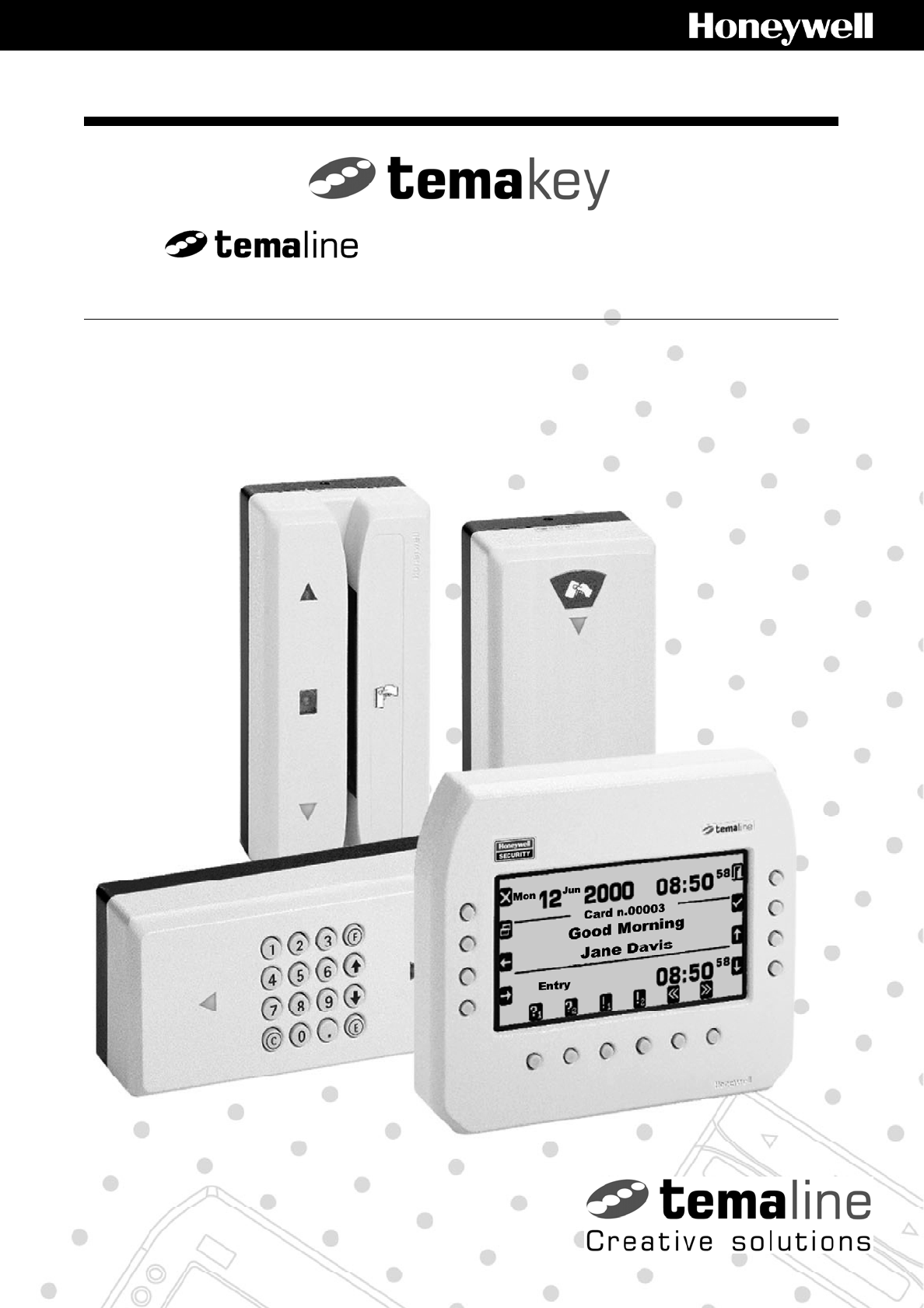
TABLE OF CONTENTS Page 3
Modular terminal
Installation Manual

Page 4 Installation Manual
TABLE OF CONTENTS
Installation Manual........................................................................................ 3
FCC NOTICE................................................................................................. 6
Canadian Compliance Statement ......................................................... 6
PRELIMINARY OPERATIONS .......................... 7
Mounting Instructions ................................................................................... 7
Arranging the Cable Tubes and Junction Boxes ......................................... 8
Cabling: Recommendations ................................................................. 8
Electrical Connections................................................................................ 10
LONWORKS Data Cables......................................................................... 11
Mounting the Unit on the Wall .................................................................... 13
Horizontal Assembly – Single Module ................................................ 13
Horizontal Assembly – Triple Module ................................................. 14
Combined Assembly - Single and Triple Modules ............................. 15
Fastening the Cables .......................................................................... 17
Vertical Assembly ................................................................................ 18
Channeling the Cables from the Bottom of the Box ........................... 19
INSTALLATION ........................................... 20
Combining the Modules ............................................................................. 20
Reader ................................................................................................. 20
Keyboards ........................................................................................... 20
Display................................................................................................. 20
Terminals ............................................................................................. 21
Terminals with Keyboards................................................................... 21
Interactive Terminals ........................................................................... 22
Interactive Terminals with Keyboards ................................................. 22
Attaching the Modules to the Wall.............................................................. 23
Applying the Entry/Exit Labels.................................................................... 24
Identification via Bar Code.......................................................................... 25
Summary of Modular Devices .................................................................... 26
RTU-B07 (Proxy Reader for HID Cards)............................................................ 27
RTU-B12 (Proxy Reader for MIFARE Cards)...................................................... 28
RTU-C01 (Alphanumeric LCD Module)............................................................. 29
RTU-C02 (Graphic LCD Module) ..................................................................... 30

Installation Manual Page 5
RTU-T01 (Numeric Keyboard Module) ............................................................. 31
Optional Parts ............................................................................................. 32

Page 6 FCC NOTICE
FCC NOTICE
NOTE: This equipment has been tested and found to comply with the limits
for a Class B digital device, pursuant to Part 15 of FCC Rules. These limits
are designed to provide reasonable protection against harmful interference
in a residential installation. This equipment generates, uses and can radiate
radio frequency energy and, if not installed and used in accordance with the
instructions, may cause harmful interference to radio communications.
However, these is no guarantee that interference will not occur in a particular
installation.
If this equipment does cause harmful interference to radio or television
reception, which can be determined by tuning the equipment off and on, the
user is encouraged to try to correct the interference by one or more the
following measures:
-- Reorient or relocate the receiving antenna.
-- Increase the separation between the equipment and receiver.
-- Connect the equipment into an outlet on a circuit different from that to
which the receiver is connected.
-- Consult the dealer or an experienced radio/TV technician for help.
Caution: any modification or change not expressely approved by the party
responsible for compliance could void the user’s authority to operate the
equipment.
Canadian Compliance Statement
This Class B Digital apparatus meets all the requirements of the Canadian
Interference-Causing Equipment Regulations.
Cet appareil numerique de la classe B respecte les exigences du Reglement
sur le material broilleur du Canada.
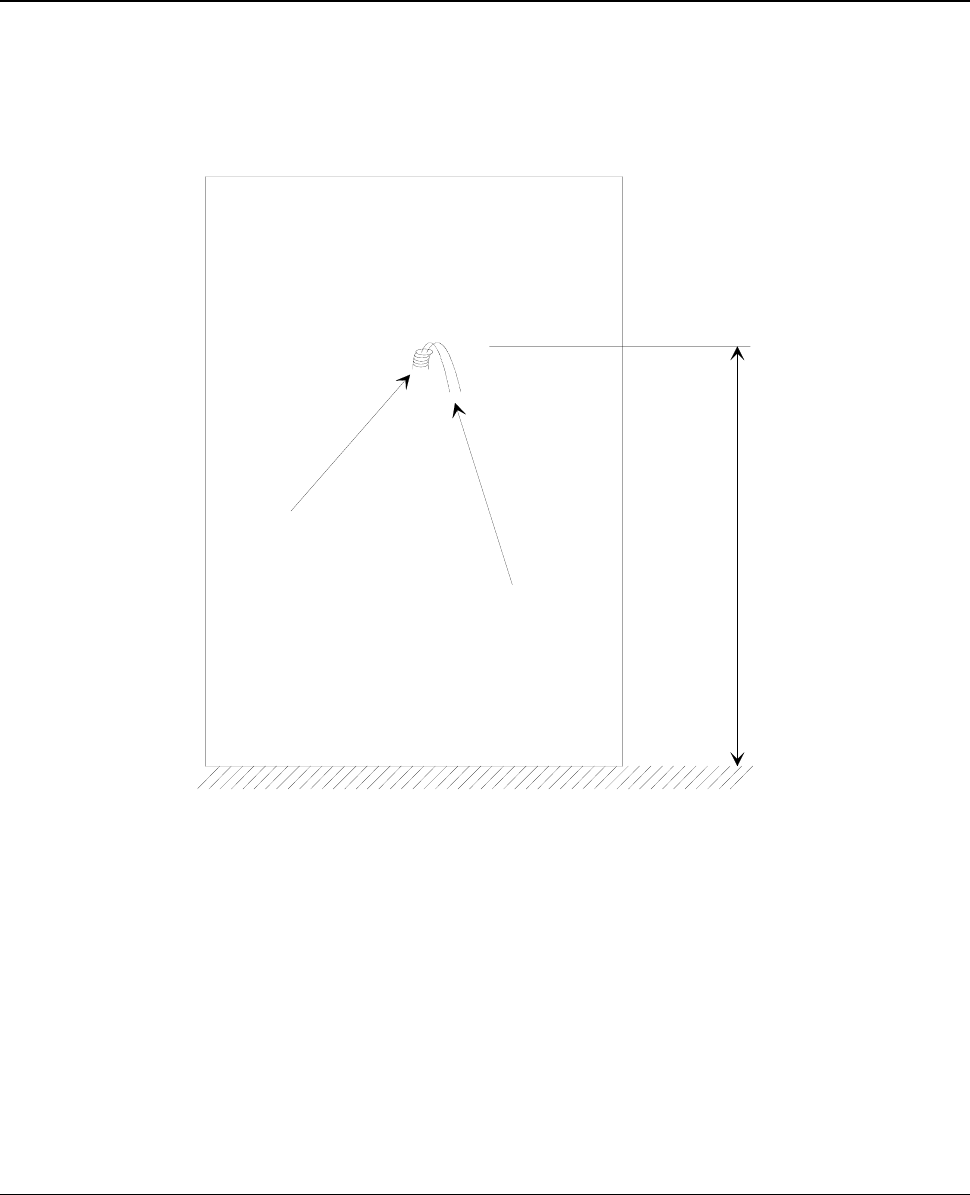
Mounting Instructions Page 7
PRELIMINARY OPERATIONS
Mounting Instructions
The cables are attached to an encased box. Make sure that you place the
box at a height of 120cm from the floor (see Figure 1).
tube
cables
120 cm
floor
Figure 1: Space requirements for mounting
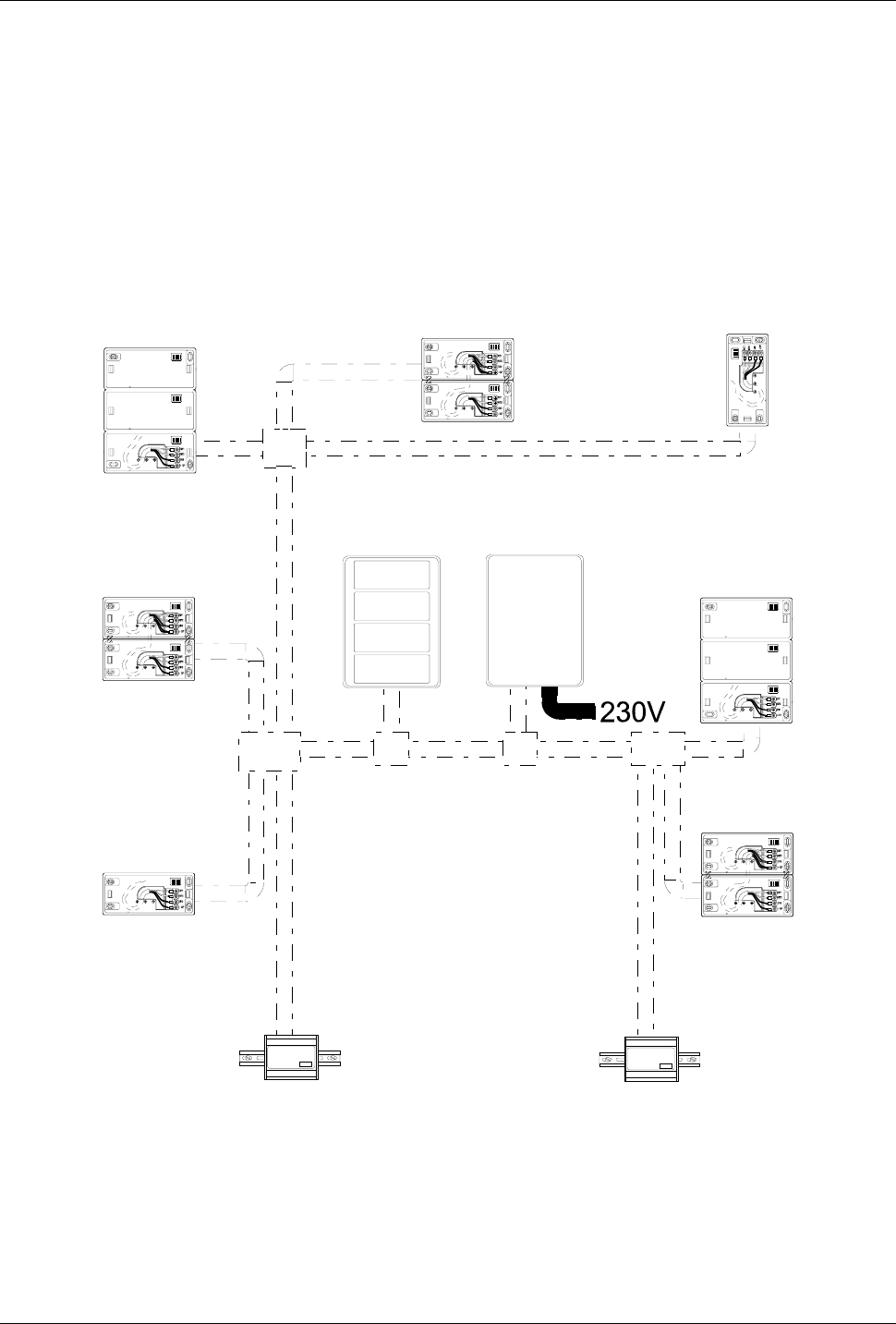
Page 8 Arranging the Cable Tubes and Junction Boxes
Arranging the Cable Tubes and Junction
Boxes
All the cables consist of 4 wires that must be connected in parallel from one
node to the next. It is possible to link nodes in free topology, i.e. by means of
a star or bus configuration.
Cabling: Recommendations
Figure 2 provides an example of a typical free topology installation.
TemaServer
TemaPower
Figure 2: Example of a free topology installation
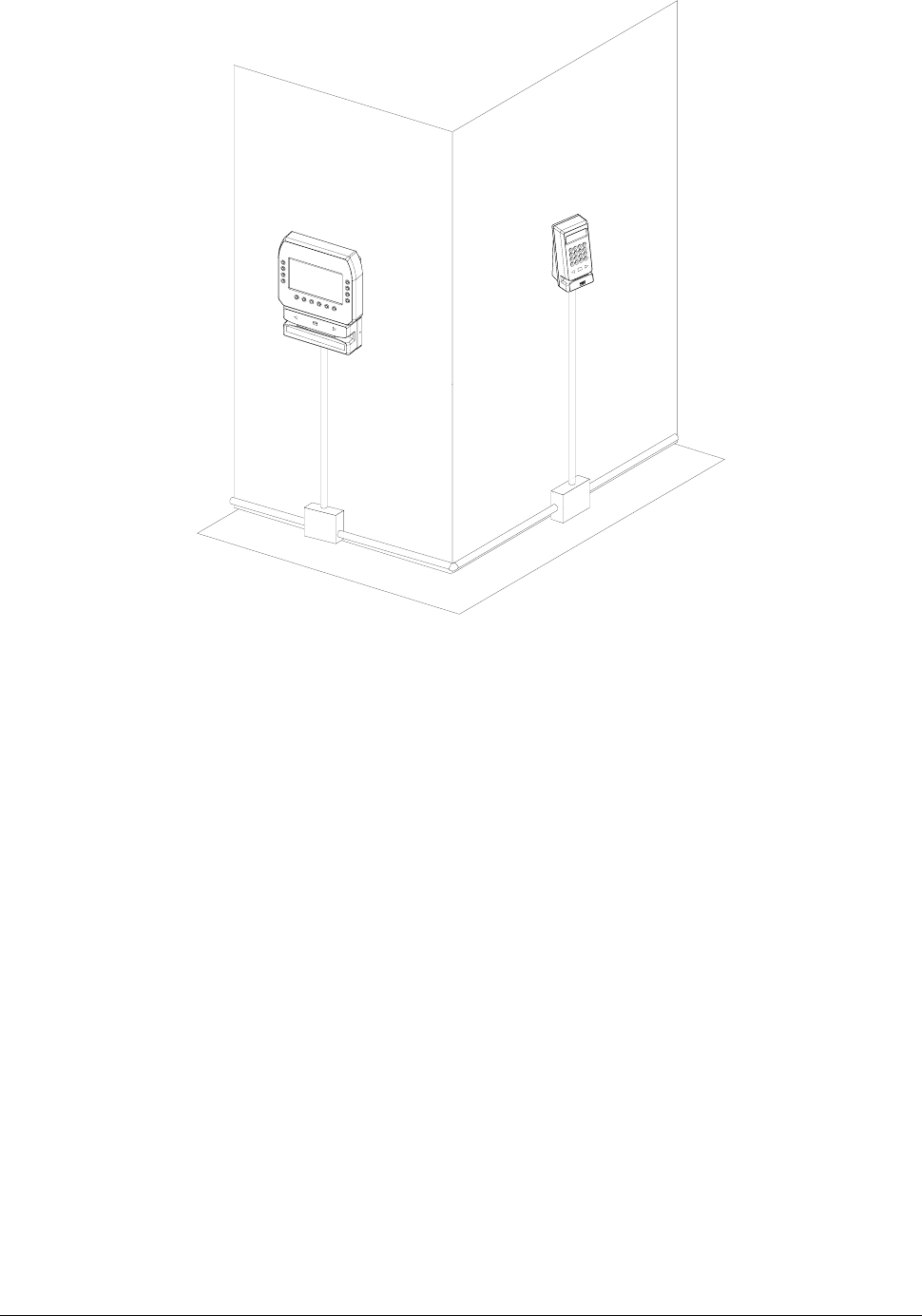
Arranging the Cable Tubes and Junction Boxes Page 9
If you want to mount the tubes on the surface of the walls, it is advisable to
place the junction boxes under each terminal (see example in Figure 3).
Figure 3: Location of the junction boxes
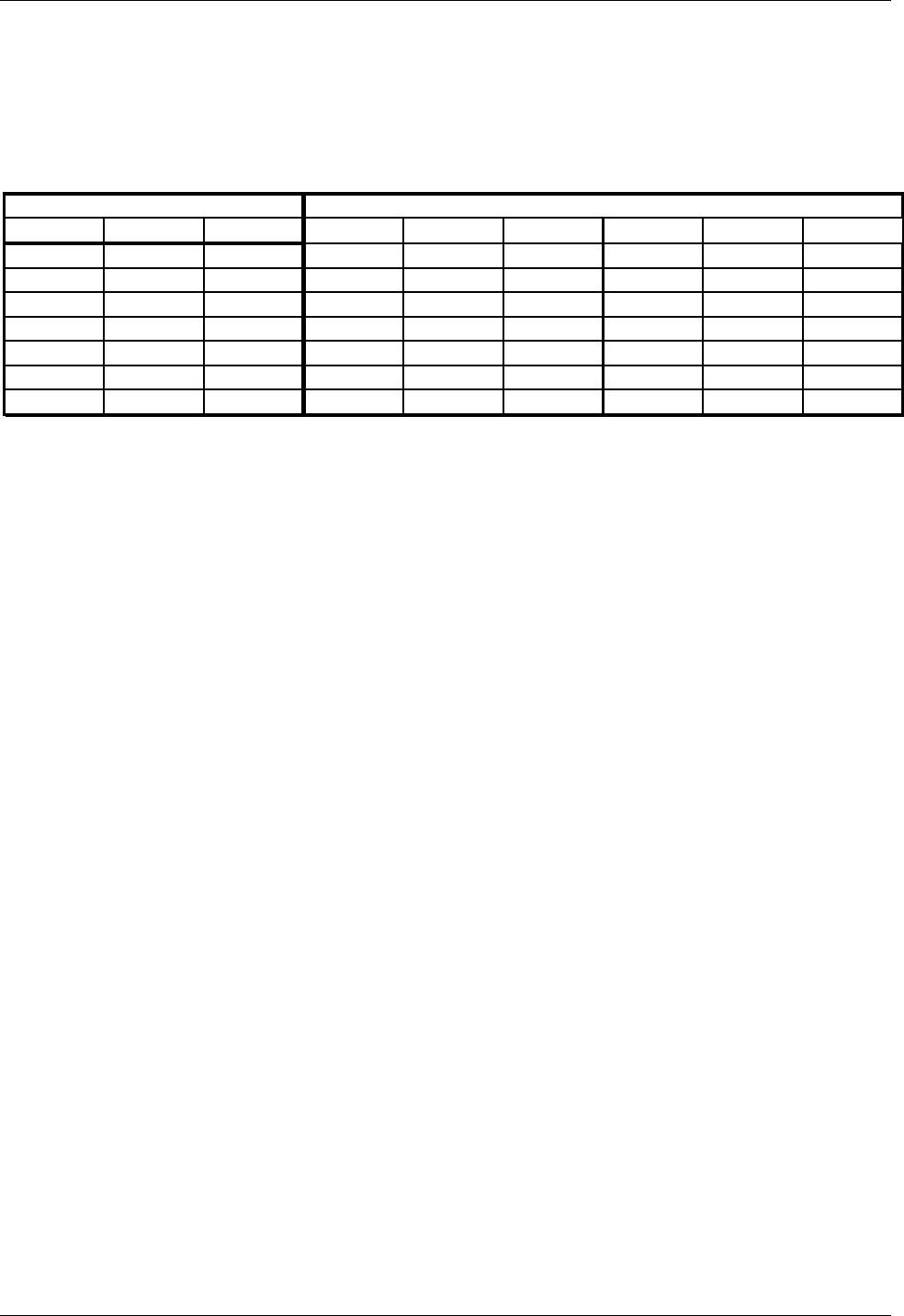
Page 10 Electrical Connections
Electrical Connections
The RTU is powered at low voltage (12VDC 120mA) by a battery-operated
power supply module (RTU-Qxx). When determining the correct size for
power cables, refer to the table below.
Type of cable Lengt h (m) in r elat ion t o effect ive load
A
WG mm2 ohm/Km 100 [mA] 200 [mA] 500 [mA] 1 [A] 2 [A] 5 [A]
12 3,3 5,7 1754 877 351 175 88 35
14 2 8,8 1136 568 227 114 57 23
16 1,3 14 714 357 143 71 36 14
18 0,9 21 476 238 95 48 24 10
20 0,6 34 294 147 59 29 15 6
22 0,35 52 192 96 38 19 10 4
24 0,2 85 118 59 24 12 6 2
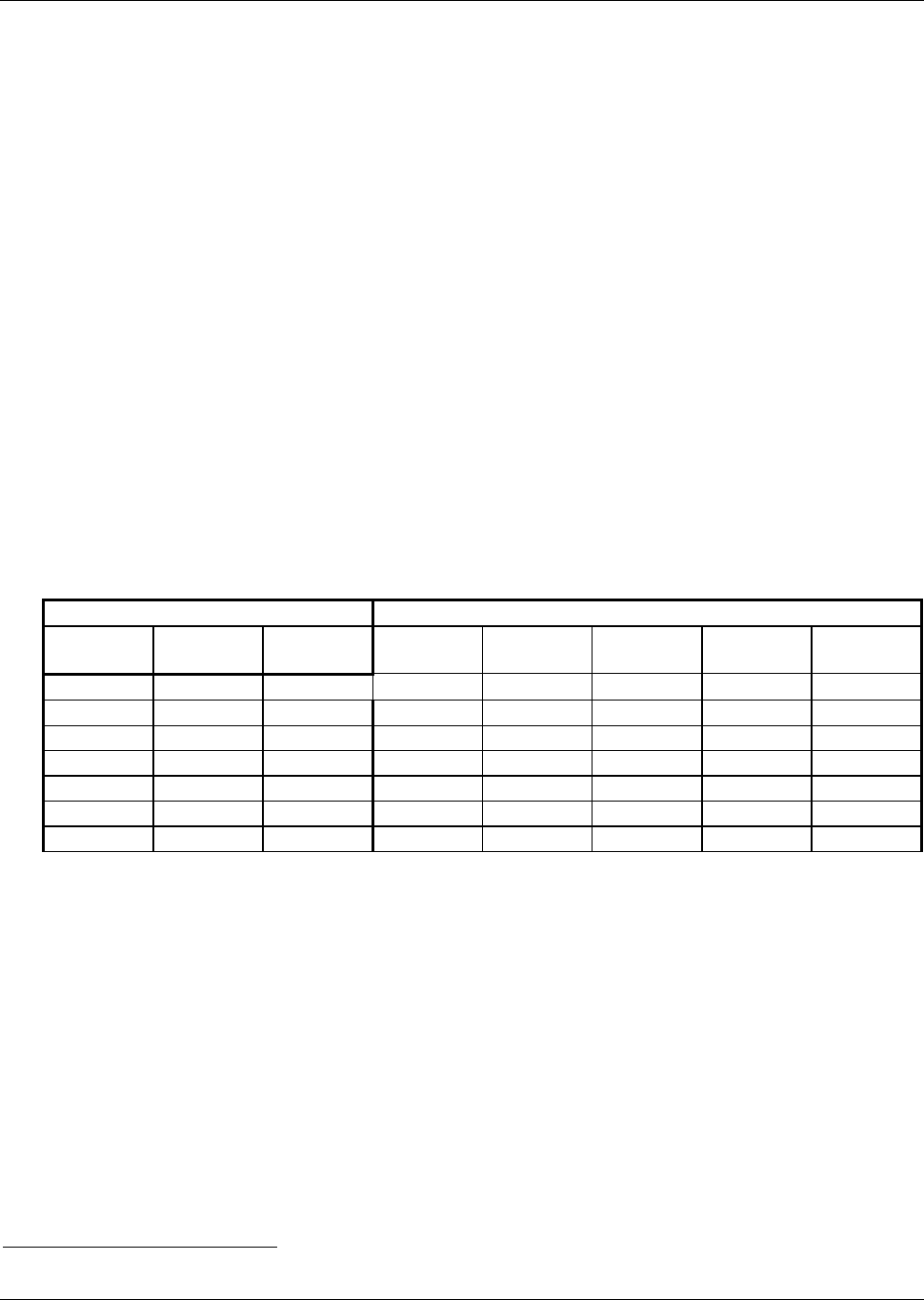
LONWORKS( Data Cables Page 11
LONWORKS Data Cables
• The LONWORKS1 data cable must be twisted pair
• In a free topology configuration, the sum total of the sections must not
exceed 500m
• In a bus configuration, the sum total of the sections must not exceed
2700m
• In a free topology configuration, activate the 50ohm terminator by placing
the appropriate jumper on the FTT10A plug-in of the CTU-PLG06 board
inside the TemaServer
• In a bus configuration, place two terminators (with resistance values of
100ohm 1% ½W) at each end of the bus
• Check that the length of the LONWORKS data cable corresponds to the
norms indicated in Table 1.
Type of cable Length [m] in relation to cable capacity
AWG mm2 Ohm/Km 50nF/Km 100nF/K
m
200nF/K
m
500nF/K
m
1uF/Km
12 3,3 5,7 2676 1892 1338 846 598
14 2 8,8 2153 1523 1077 681 482
16 1,3 14 1707 1207 854 540 382
18 0,9 21 1394 986 697 441 312
20 0,6 34 1096 775 548 346 245
22 0,35 52 886 626 443 280 198
24 0,2 85 693 490 346 219 155
Table 1: Length/capacity of LONWORKS
data cables (m)
1 LONWORKS® is a trademark of Echelon Corporation
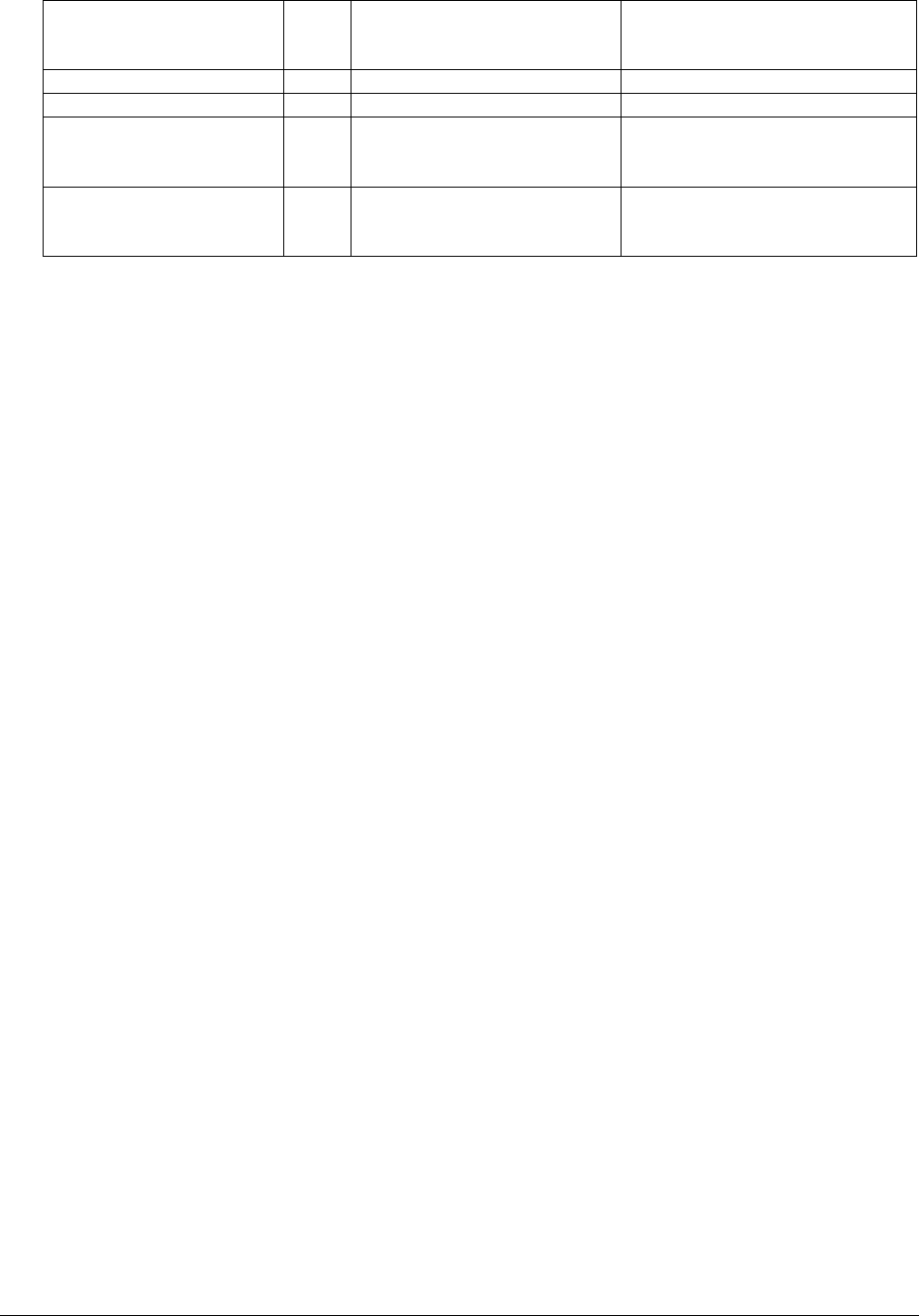
Page 12 LONWORKS( Data Cables
• The FTT10A Echelon v1.2 User Guide recommends the cables indicated
in Table 2.
Manufacturer and
model
AWG Connection to bus -
maximum total length
[m]
Connection in free topology
–maximum node-node
length max. [m]
Belden 85102 16 2700 500
Belden 8471 16 2700 400
Level IV (twisted pair,
typically solid and
unshielded)
22 1400 400
JY (St) 2x2x0.8 (4-
wire helical twist,
solid shielded)
20 900 320
Table 2: Recommended LONWORKS
cables
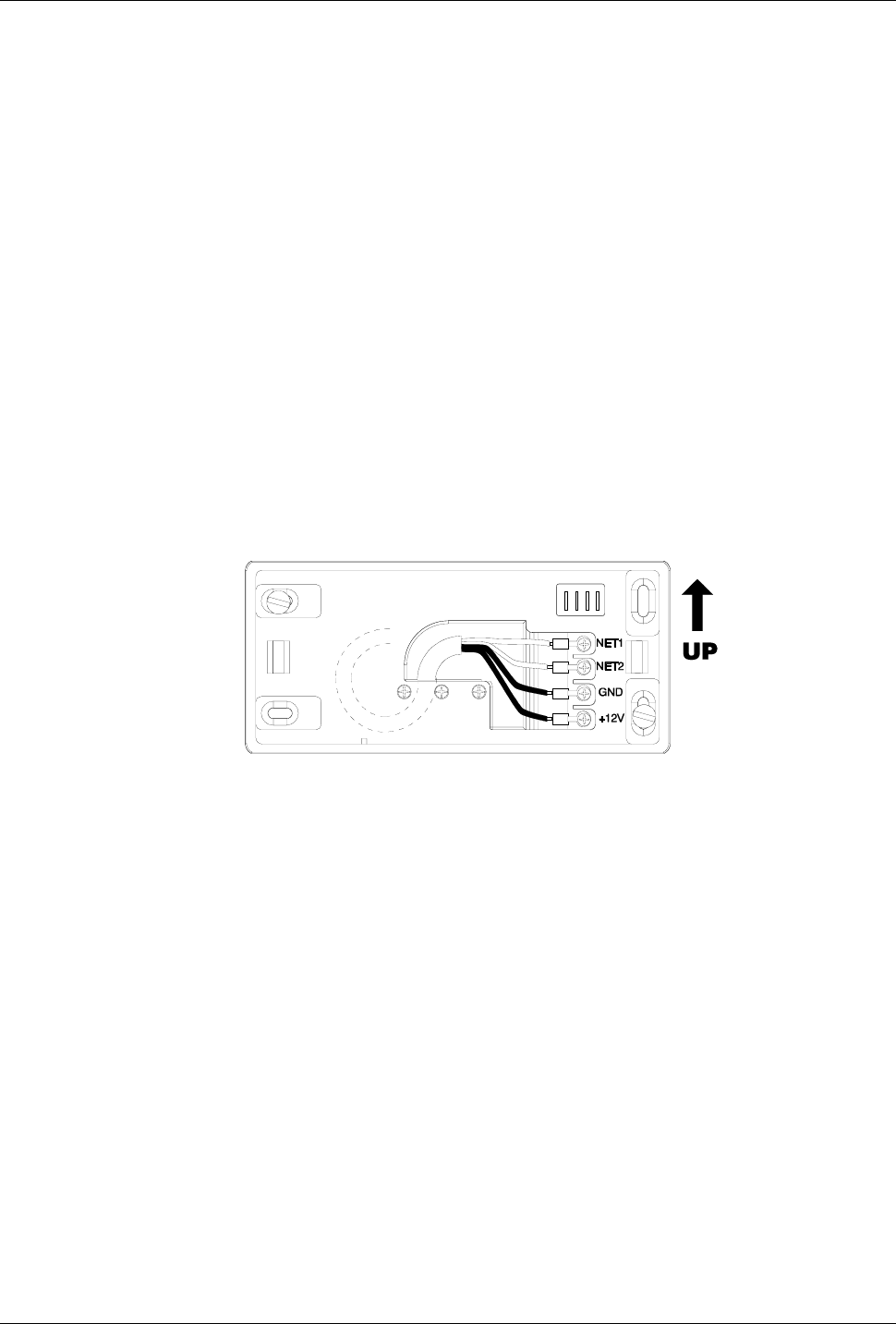
Mounting the Unit on the Wall Page 13
Mounting the Unit on the Wall
Horizontal Assembly – Single Module
To assemble the unit in a horizontal position, follow these steps:
1. Drill two holes in the wall (to accommodate the 2 plastic dowels), so that
the frame will cover the hole through which the cables pass.
2. Insert the cables in the cable clamp without pulling out the screws.
3. Use the dowels to fasten the frame to the wall. Make sure that the lamellar
connector is in the UP position.
4. Adjust the length of the cables so that they protrude by ~10cm from the
wall, and fasten them to the cable crimp.
5. Fasten the cable crimp to the contacts in the direction shown in Figure 4.
6. Place the remainder of the cable inside the frame and lock the cable
clamp.
Figure 4: Wall position – horizontal position (single module)
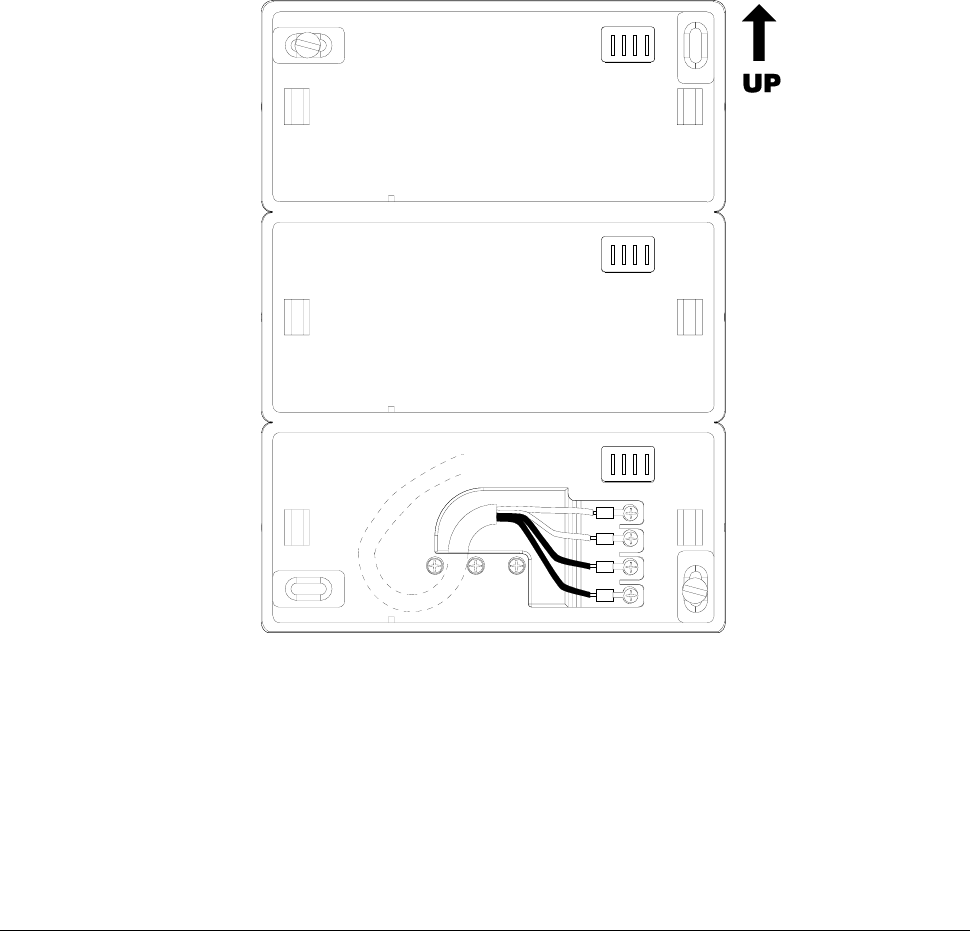
Page 14 Mounting the Unit on the Wall
Horizontal Assembly – Triple Module
To assemble the unit in a horizontal position, follow these steps:
1. Drill two holes in the wall (to accommodate the 2 plastic dowels), so that
the frame will cover the hole through which the cables pass.
2. Insert the cables in the cable clamp without pulling out the screws.
3. Use the dowels to fasten the frame to the wall. Make sure that the lamellar
connector is in the UP position.
4. Adjust the length of the cables so that they protrude by ~10cm from the
wall, and fasten them to the cable crimp.
5. Fasten the cable crimp to the contacts in the direction shown in Figure 5.
6. Place the remainder of the cable inside the frame and lock the cable
clamp.
NET1
NET2
GND
+12V
Figure 5: Wall position – horizontal position (triple module)
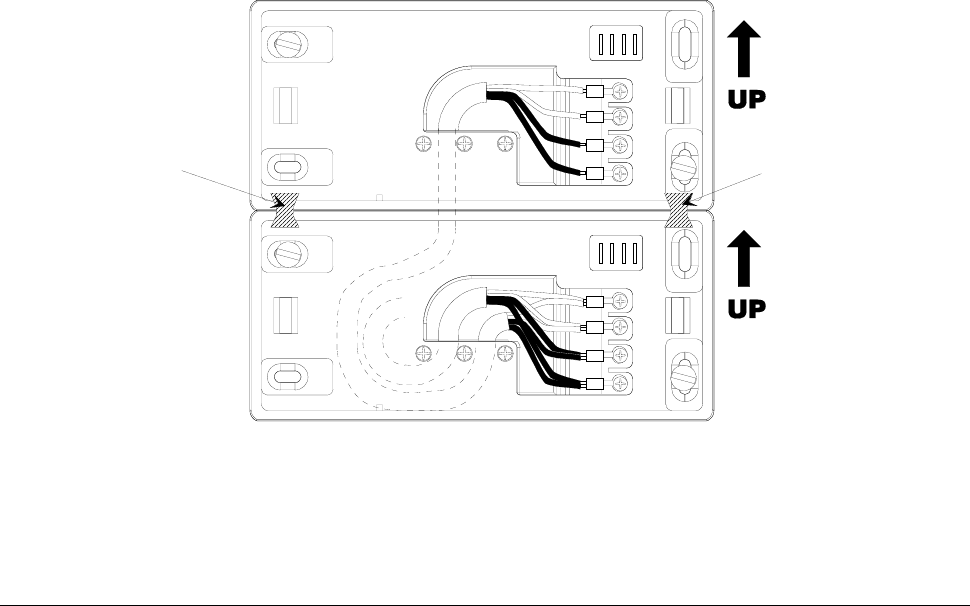
Mounting the Unit on the Wall Page 15
Combined Assembly - Single and Triple Modules
A combined wall assembly of single and triple modules allows you to create
units consisting of 2, 4 and 5 units. This procedure consists of the following
steps:
1. Drill the necessary holes in the wall (2 plastic dowels for each module), so
that the lower plate will cover the hole through which the cables pass.
2. Insert the cables in the cable clamp without pulling out the screws.
3. Link the frames together by inserting the two enclosed attachment clips at
the rear of the frames (see Figure 6 and Figure 7).
4. Use the dowels to fasten the frame to the wall. Make sure that the lamellar
connector is in the UP position.
5. Adjust the length of the cables so that they protrude by ~10cm from the
wall, and fasten them to the cable crimp.
6. Intertwine the terminators of the cables from the wall and the extension
cable terminators, and fasten them to the cable crimps.
7. Fasten the cable crimp to the contacts in the direction shown in Figure 6
and Figure 7.
8. Place the remainder of the cable inside the frame and lock the cable
clamp.
NET1
NET2
GND
+12V
NET1
NET2
GND
+12V
At t achment
clip At t achment
clip
Figure 6: Combined assembly of two single module wall units
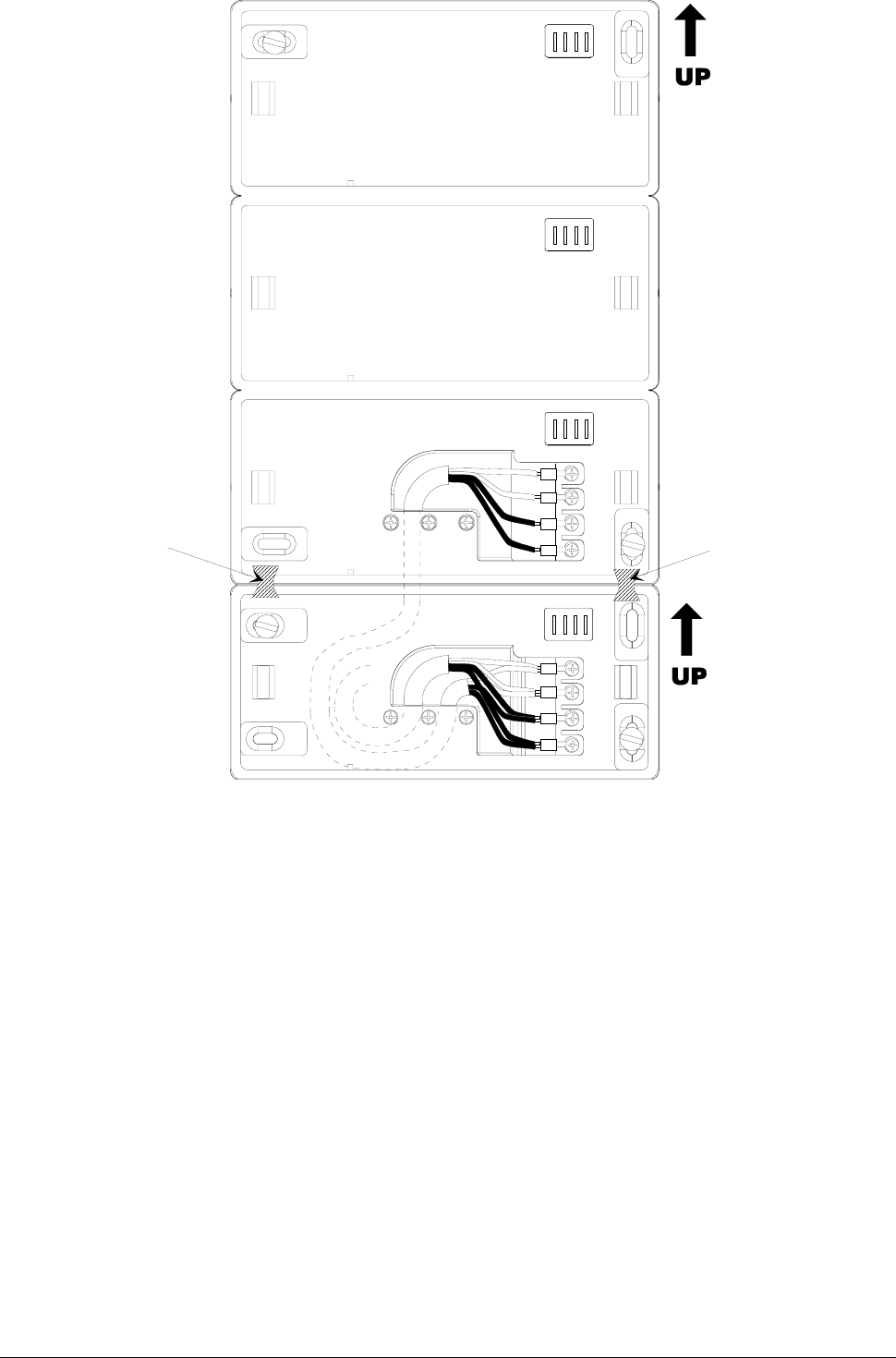
Page 16 Mounting the Unit on the Wall
NET1
NET2
GND
+12V
NET1
NET2
GND
+12V
At t achment
clip
At t achment
clip
Figure 7: Combined assembly of single and triple module wall units
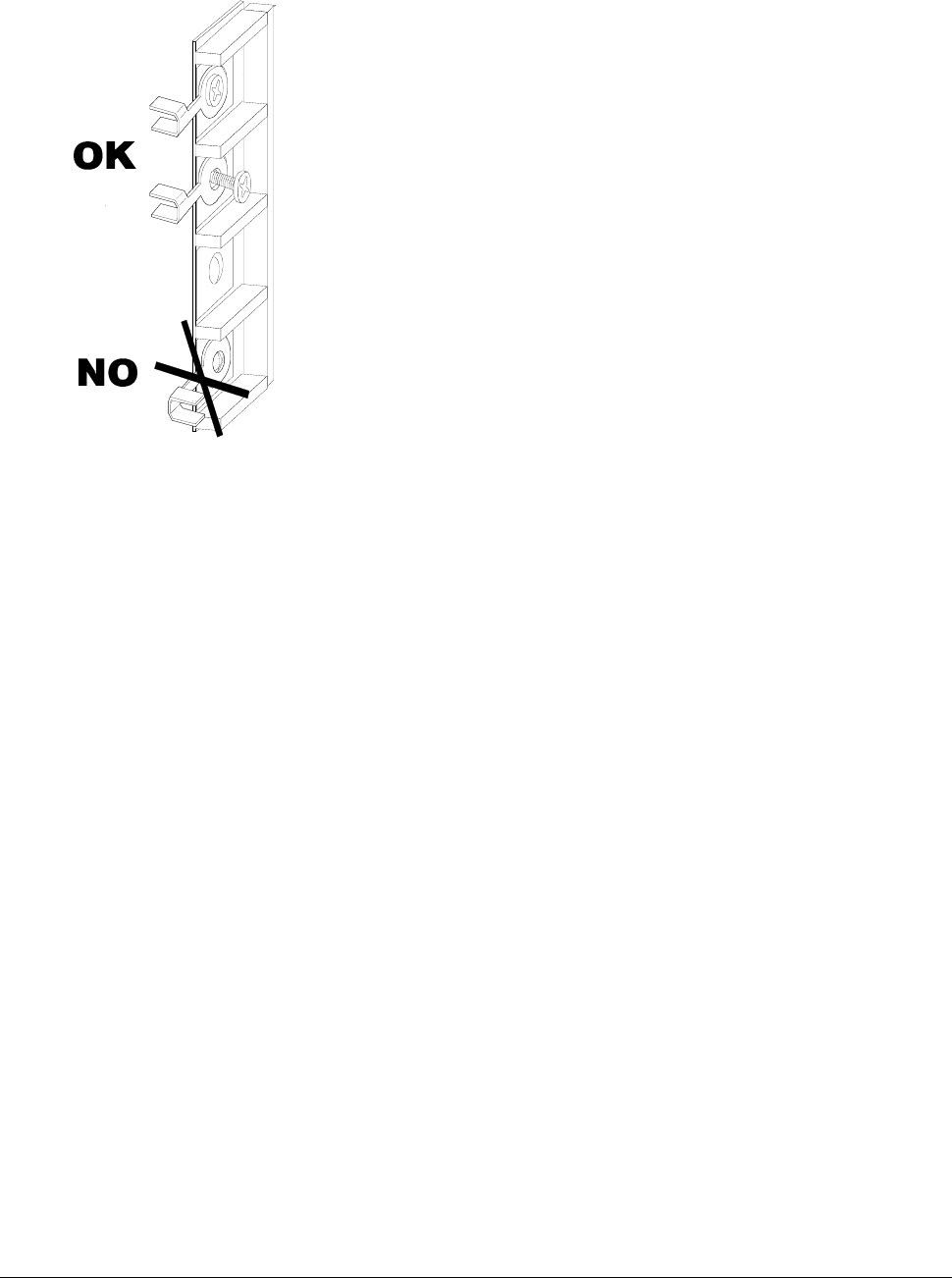
Mounting the Unit on the Wall Page 17
Fastening the Cables
Fasten the cable clamps to the cable bar so that the cables are arranged
towards the inside of the frame (see Figure 8).
CONNECTIONS
Å NET1 (green)
Å NET2 (yellow)
Å GND (black)
Å +12V (red)
Figure 8: Fastening the cables

Page 18 Mounting the Unit on the Wall
Vertical Assembly
To assemble the unit in a vertical position, follow these steps:
1. Drill two holes in the wall (to accommodate the 2 plastic dowels), so that
the frame will cover the hole through which the cables pass.
2. Insert the cables in the cable clamp without pulling out the screws.
3. Use the dowels to fasten the frame to the wall. Make sure that the lamellar
connector is in the UP position.
4. Adjust the length of the cables so that they protrude by ~10cm from the
wall, and fasten them to the cable crimp.
5. Fasten the cable crimp to the contacts in the direction shown in Figure 9.
6. Place the remainder of the cable inside the frame and lock the cable
clamp.
NET1
NET2
GND
+12V
NET1
NET2
GND
+12V
NET1
NET2
GND
+12V
Figure 9: Wall position – vertical assembly
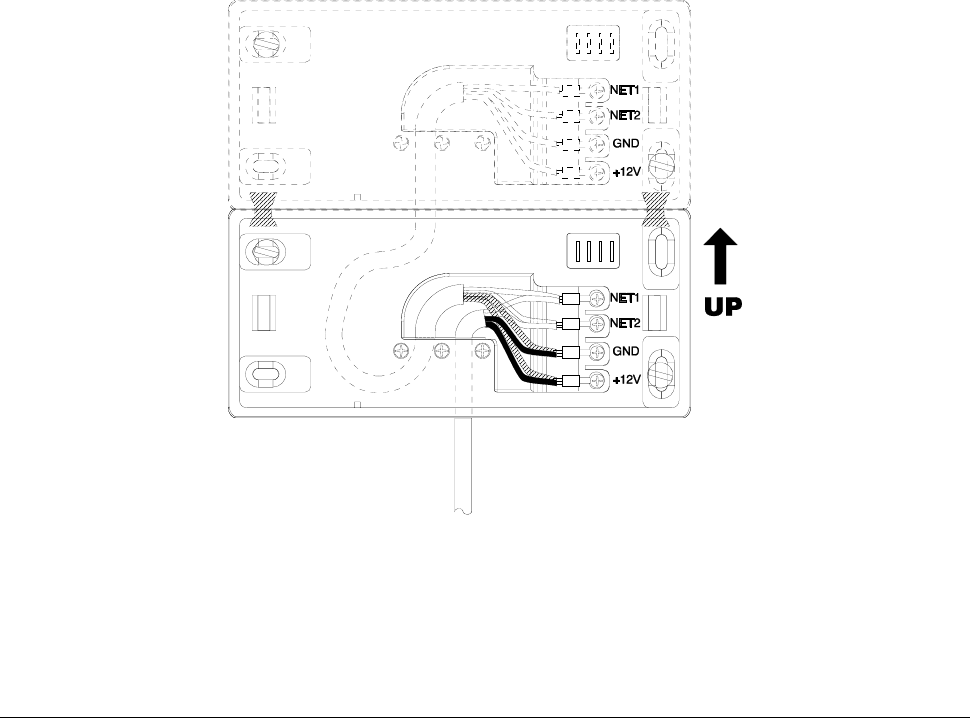
Mounting the Unit on the Wall Page 19
Channeling the Cables from the Bottom of the Box
As an alternative, you can channel the cables so that they exit from the
bottom of the frame. This alternative procedure consists of the following
steps:
1. Drill a hole in the wall so that the hole from which the cables exit is in the
center of the lower plate.
2. Break off the lower removable tab from the upper support.
3. Break off the upper and lower tab from the lower support.
4. Insert both the cables from the wall and the remainder of the cable in the
cable clamp (be careful not to pull out the screws).
5. Use the dowels to attach the frame to the wall.
6. Adjust the length of the cables so that they protrude by ~10cm from the
wall.
7. Roll up the terminators of the cables from the wall and the extension
cables, and fasten them to the cable crimps (see Figure 10).
8. Fasten the cable crimp to the contacts in the direction shown in Figure 10.
9. Place the remainder of the cables inside the frame and lock the cable
clamps.
Figure 10: Channeling the cables from the bottom of the box
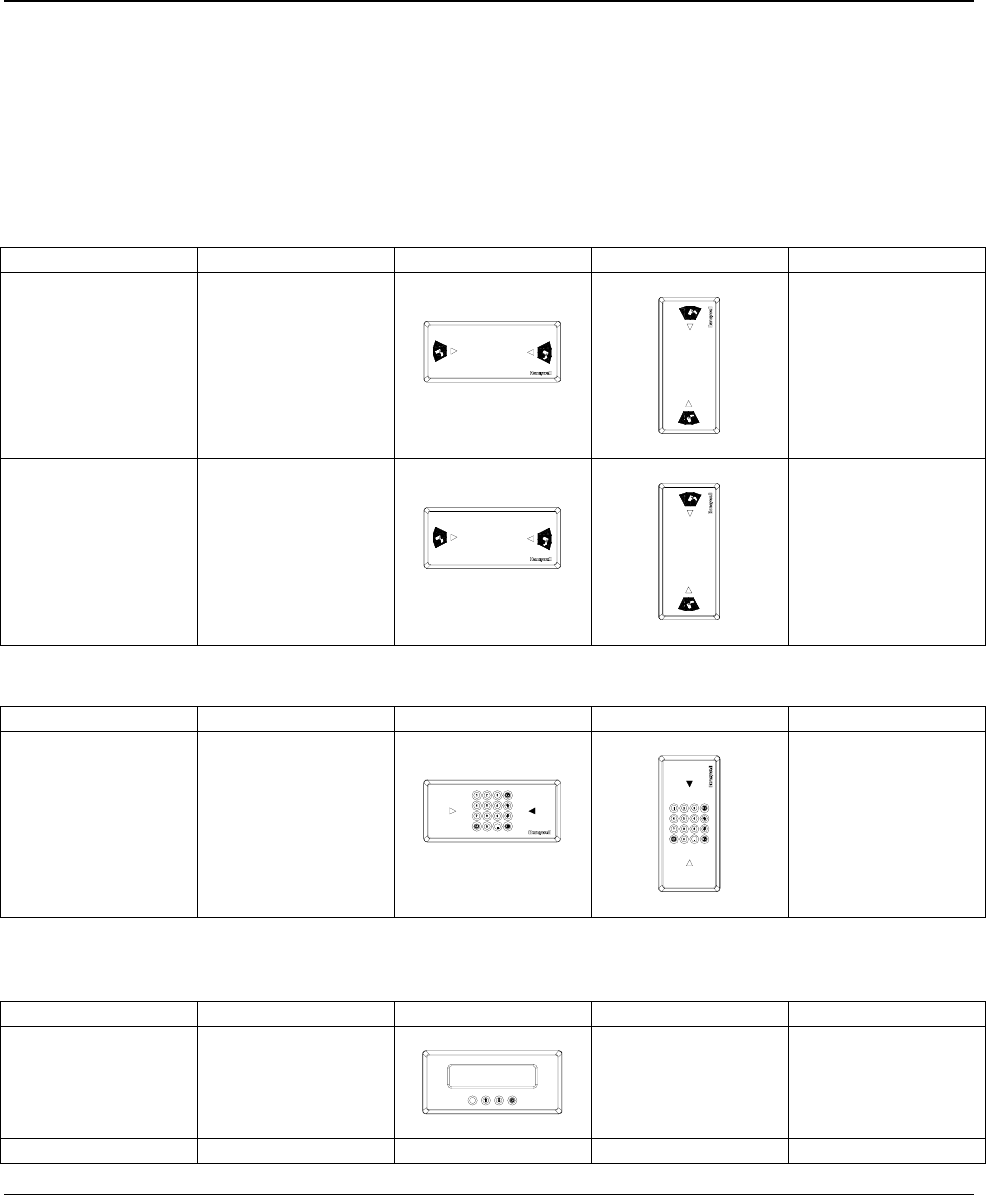
Page 20 Combining the Modules
INSTALLATION
Combining the Modules
Each TemaKey consists of one or more RTU modules that must be
positioned and connected to their respective wall attachment frames (RTU-
Sxx) as indicated in the table below.
Reader
Code Grouping Horizontal Vertical Notes
TK-S07
1 x RTU-B07
1 x RTU-S01
Weight=0.45Kg
Power=0.8W
Current=60mA
TK-S012
1 x RTU-B12
1 x RTU-S01
Weight=0.45Kg
Power=1.0W
Current=90mA
Keyboards
Code Grouping Horizontal Vertical Notes
TK-S31
1 x RTU-T01
1 x RTU-S01
Weight=0.4Kg
Power=0.4W
Current=30mA
Display
Code Grouping Horizontal Vertical Notes
TK_S21
1 x RTU-C01
1 x RTU-S01
NO
Weight=0.45Kg
Power=1.9W
Current=140mA
TK-S22
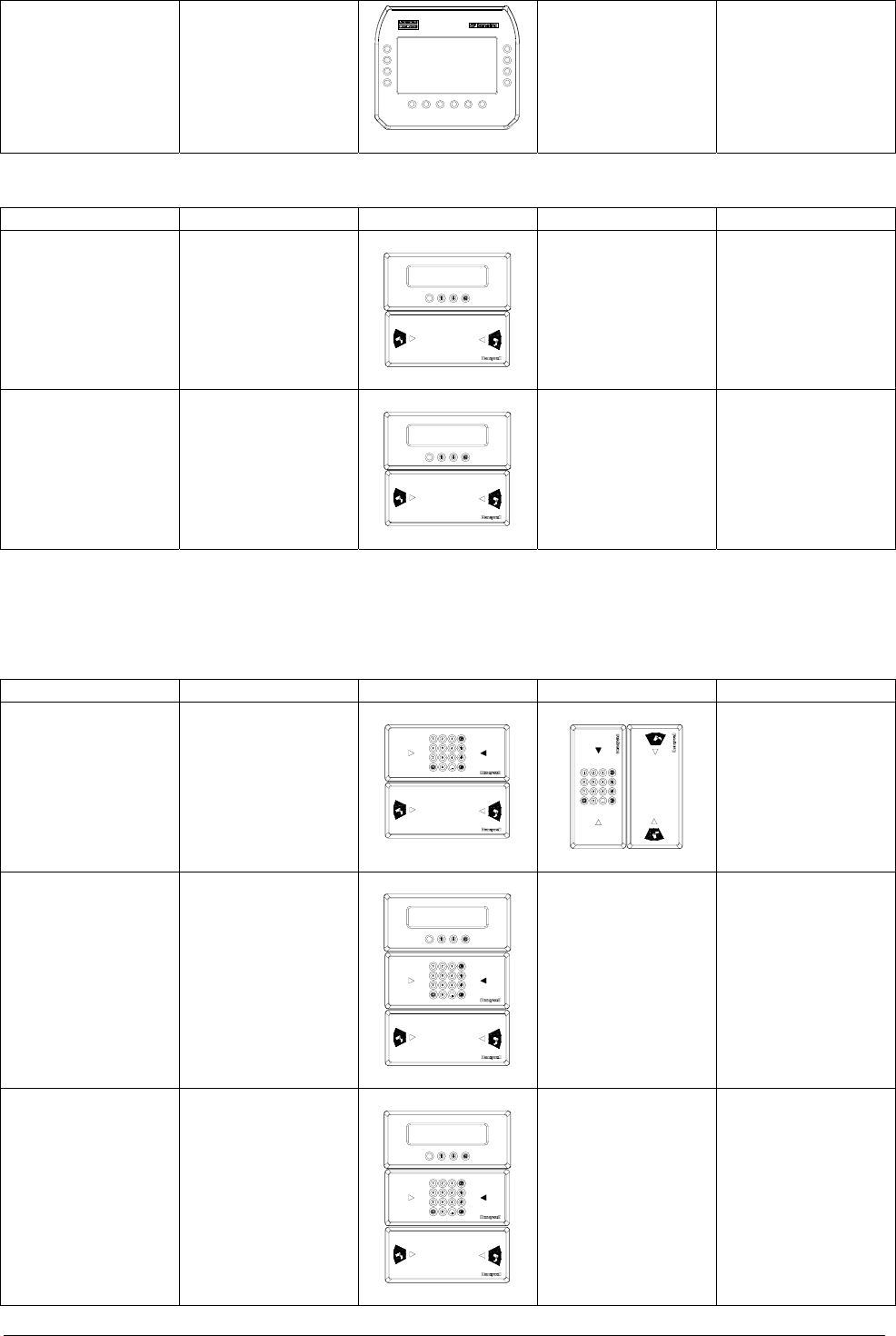
Combining the Modules Page 21
1 x RTU-C02
2 x RTU-S01
NO
Weight=0.95Kg
Power=5.2W
Current=380mA
Terminals
Code Grouping Horizontal Vertical Notes
TK-D07
1 x RTU-C01
1 x RTU-B07
2 x RTU-S01
NO
Weight=0.9Kg
Power=2.7W
Current=200mA
TK-D012
1 x RTU-C01
1 x RTU-B12
2 x RTU-S01
NO
Weight=0.9Kg
Power=2.9W
Current=200mA
Terminals with Keyboards
Code Grouping Horizontal Vertical Notes
TK_D37
1 x RTU-T01
1 x RTU-B07
2 x RTU-S01
Weight=0.85Kg
Power=1.2W
Current=90mA
TK-T07
1 x RTU-C01
1 x RTU-T01
1 x RTU-B07
1 x RTU-S03
NO
Weight=1.15Kg
Power=3.1W
Current=230mA
TK_T012
1 x RTU-C01
1 x RTU-T01
1 x RTU-B12
1 x RTU-S03
NO
Peso=1.0Kg
Potenza=3.3W
Corrente=260mA
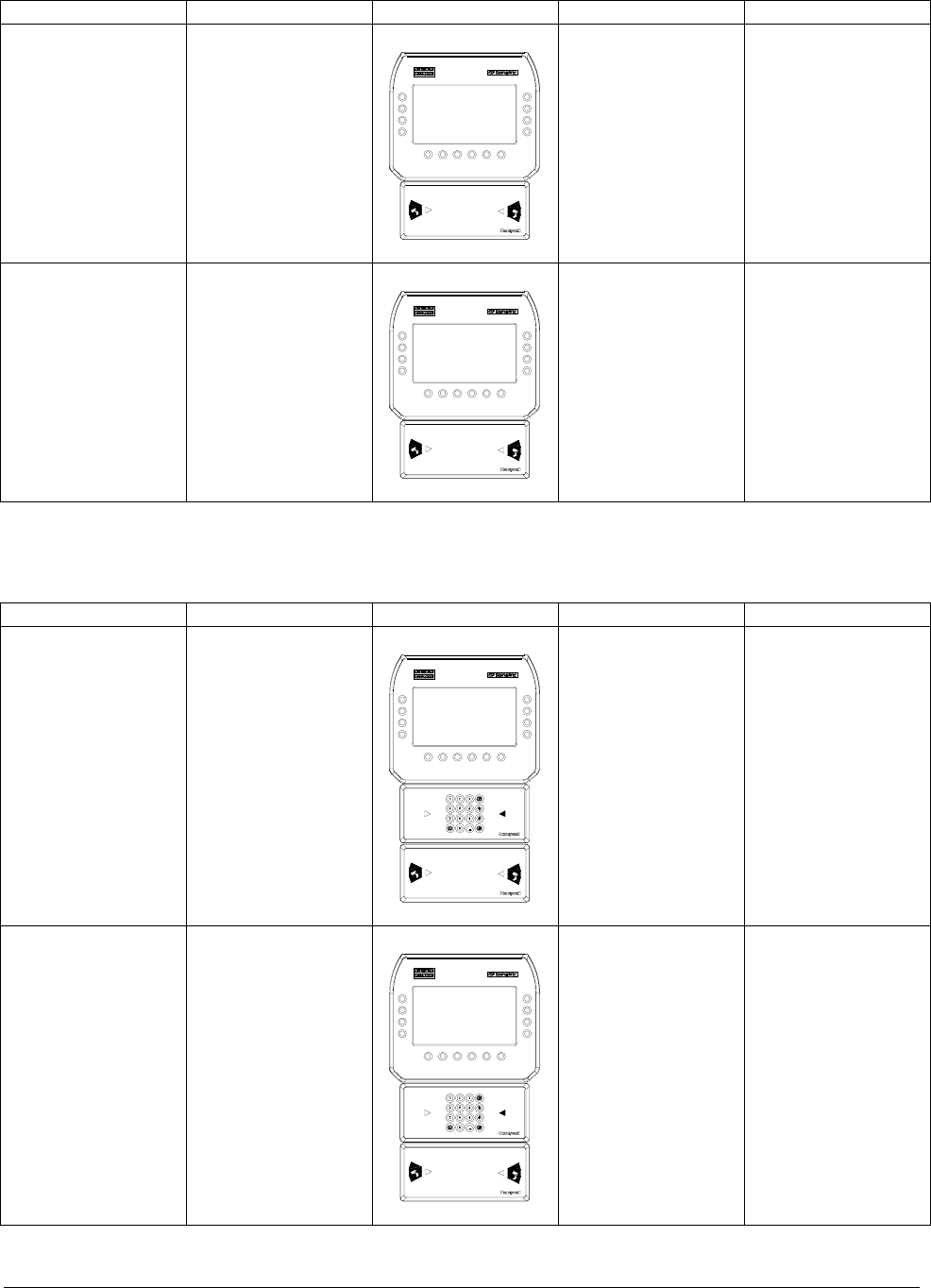
Page 22 Combining the Modules
Interactive Terminals
Code Grouping Horizontal Vertical Notes
TK-D27
1 x RTU-C02
1 x RTU-B07
1 x RTU-S03
NO
Weight=1.25Kg
Power=6W
Current=440mA
TK-D212
1 x RTU-C02
1 x RTU-B12
1 x RTU-S03
NO
Weight=1.25Kg
Power=6,2W
Current=460mA
Interactive Terminals with Keyboards
Code Grouping Horizontal Vertical Notes
TK_T27
1 x RTU-C02
1 x RTU-T01
1 x RTU-B07
1 x RTU-S03
1 x RTU-S01
NO
Weight=1.65Kg
Power=6.4W
Current=470mA
TK_T212
1 x RTU-C02
1 x RTU-T01
1 x RTU-B12
1 x RTU-S03
1 x RTU-S01
NO
Weight=1.65Kg
Power=6.6W
Current=490mA
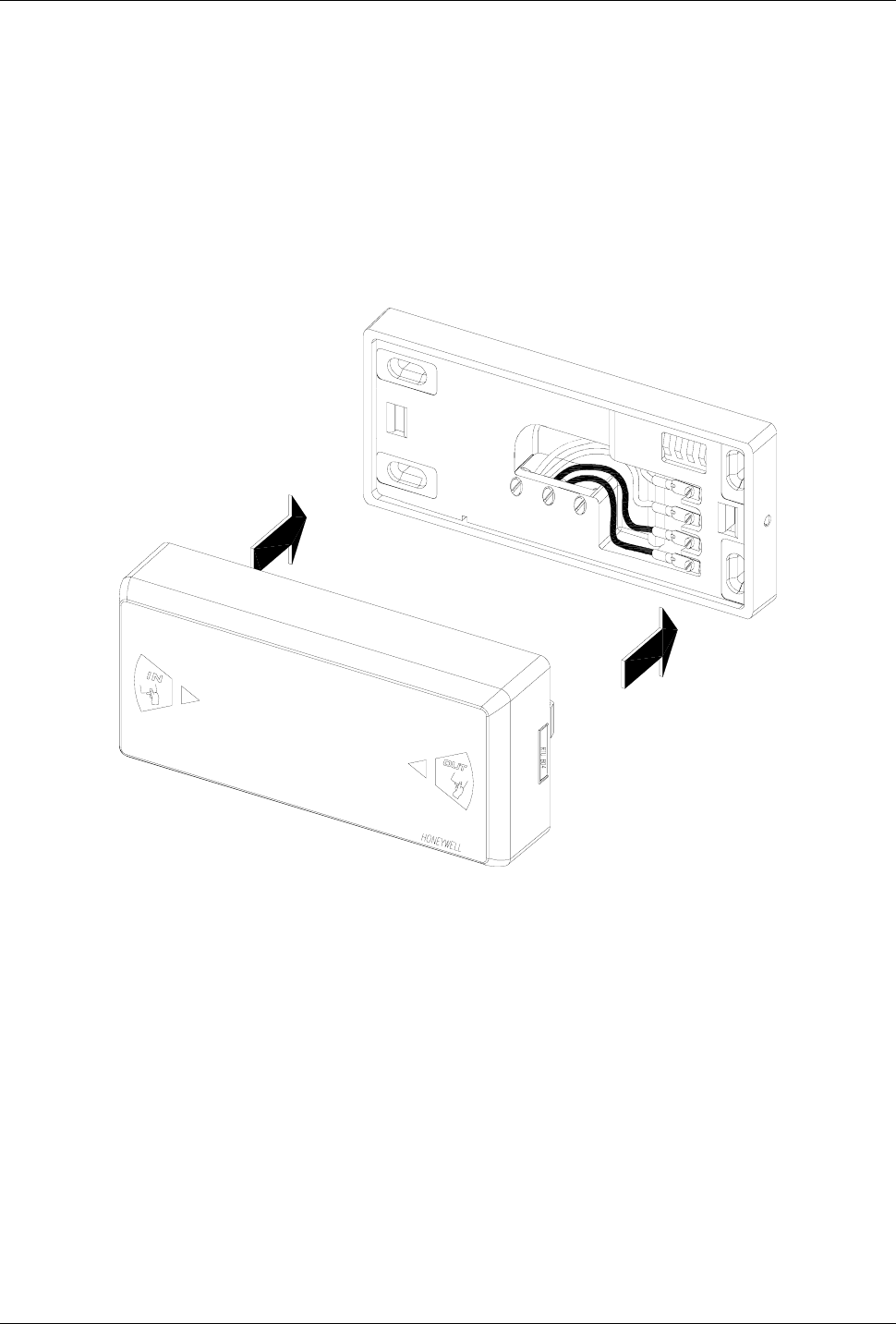
Attaching the Modules to the Wall Page 23
Attaching the Modules to the Wall
All tEmaline modules are equipped with a simple attachment
mechanism; the module clicks into position without the need for tools. To
attach the module to the frame, follow these steps:
1. Check that the fitting at the back of the RTU modules is positioned
correctly.
2. Attach each RTU module to the wall-mout frame as illustrated in Figure 11.
Figure 11: Attaching the module to the wall-mount frame
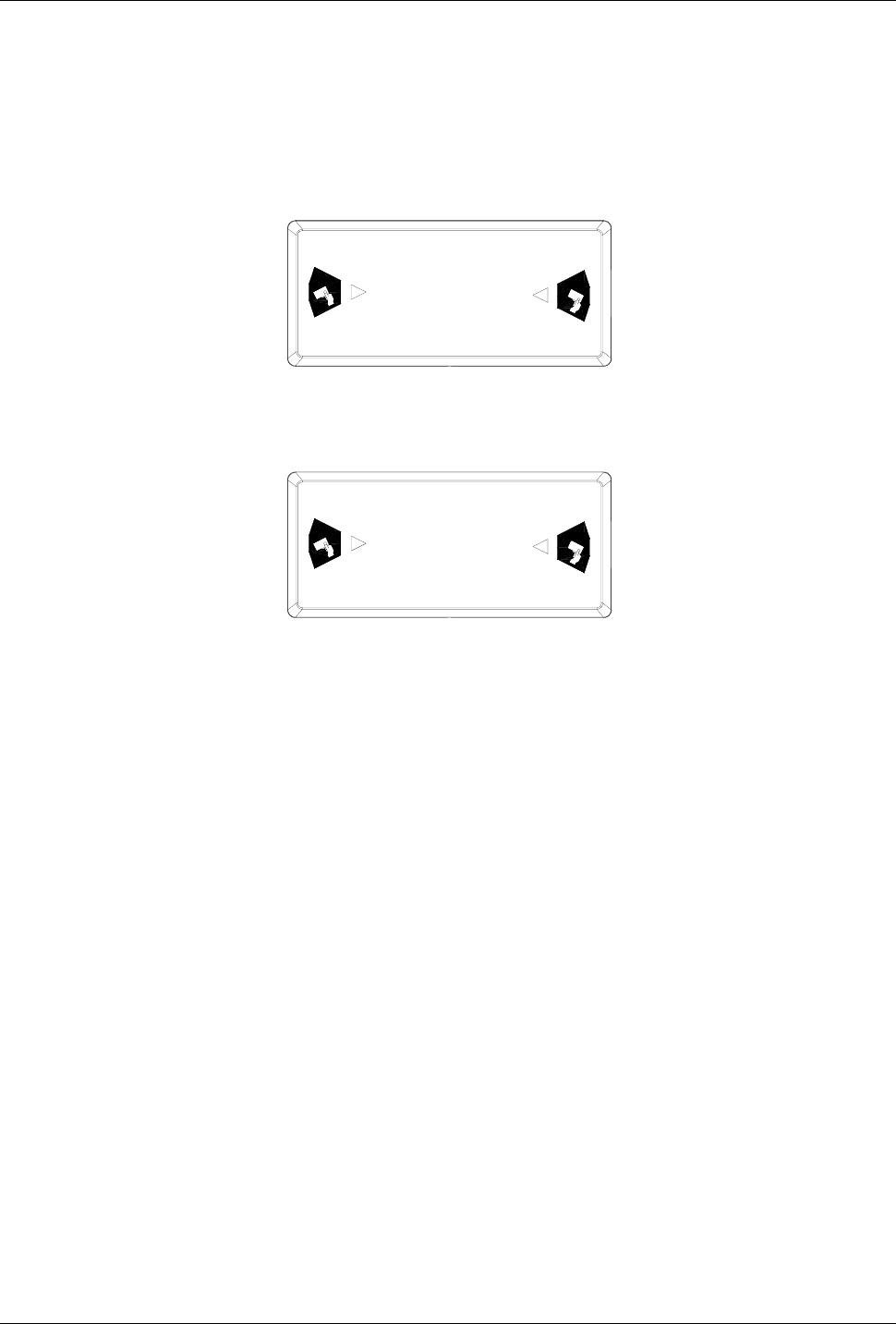
Page 24 Applying the Entry/Exit Labels
Applying the Entry/Exit Labels
Apply the two entry/exit labels to the magnetic reader according to the pre-
configured transit direction. Make sure that you place the labels in the
appropriate hollows (see details in Figure 12 and Figure 13).
IN
OUT
Å EXIT ENTRY Æ
Figure 12: Entry/exit labels
OUT
IN
Å ENTRY EXIT Æ
Figure 13: Entry/exit labels
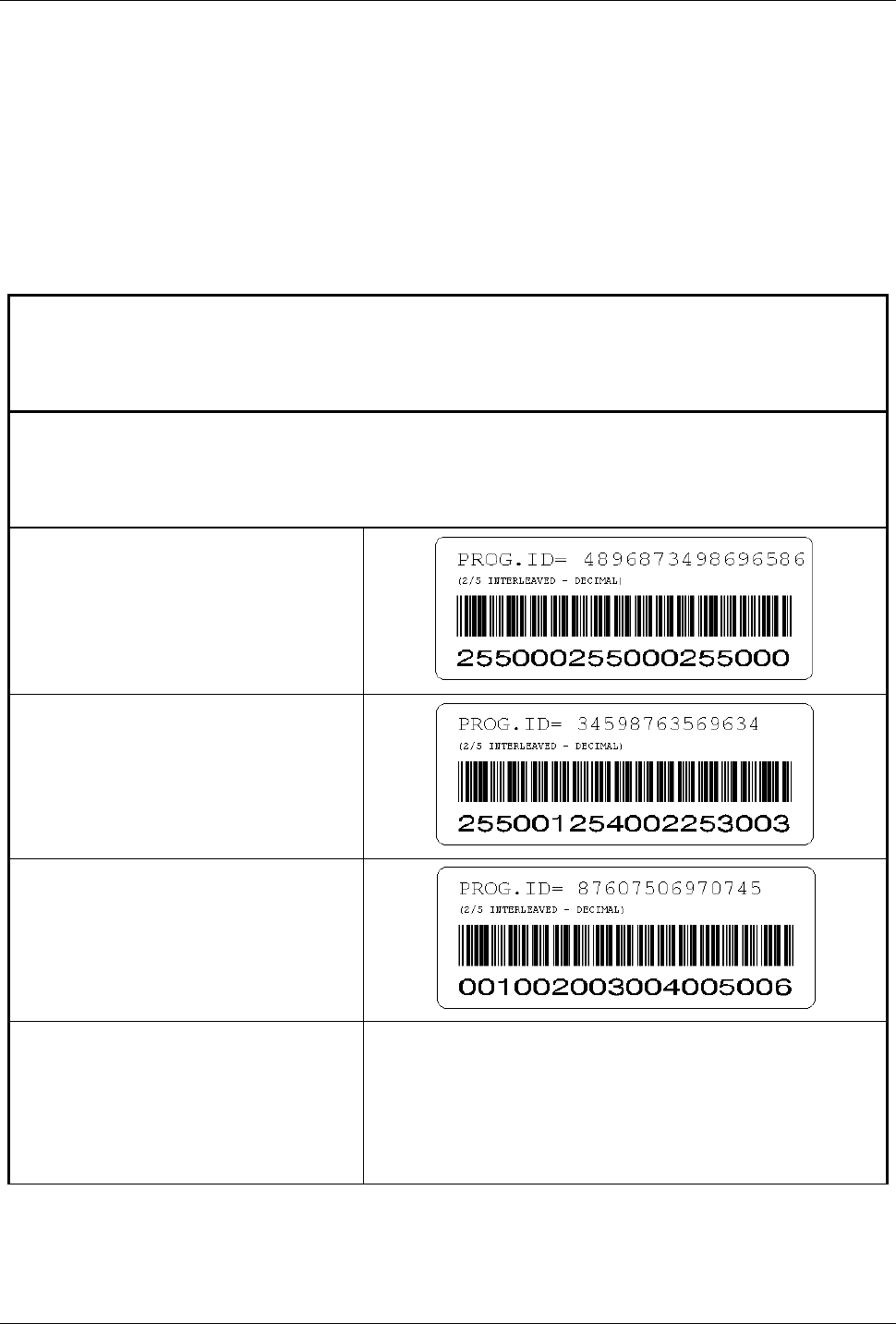
Identification via Bar Code Page 25
Identification via Bar Code
The components enclosed in the packaging include a bar code label. The
person responsible for installing the terminal must apply this label to the
corresponding identification form, and indicate the location of the terminal in
the appropriate box (see example in Table 3).
Description of location
Office entrance area, first floor - staircase E
Description of TemaServer
Panel 2 entrance area, first floor – staircase E
RTU
C01
RTU
T01
RTU
B07
RTU
-
Table 3: Example of completed identification form

Page 26 Summary of Modular Devices
TECHNICAL DATA
Summary of Modular Devices
This section contains technical data regarding the modular devices:
• RTU-B07 (Reader module for HID proxy cards)
• RTU-B12 (Reader module for Mifare proxy cards)
• RTU-C01 (Alphanumeric LCD module)
• RTU-C02 (Graphic LCD module)
• RTU-T01 (Numeric keyboard module)
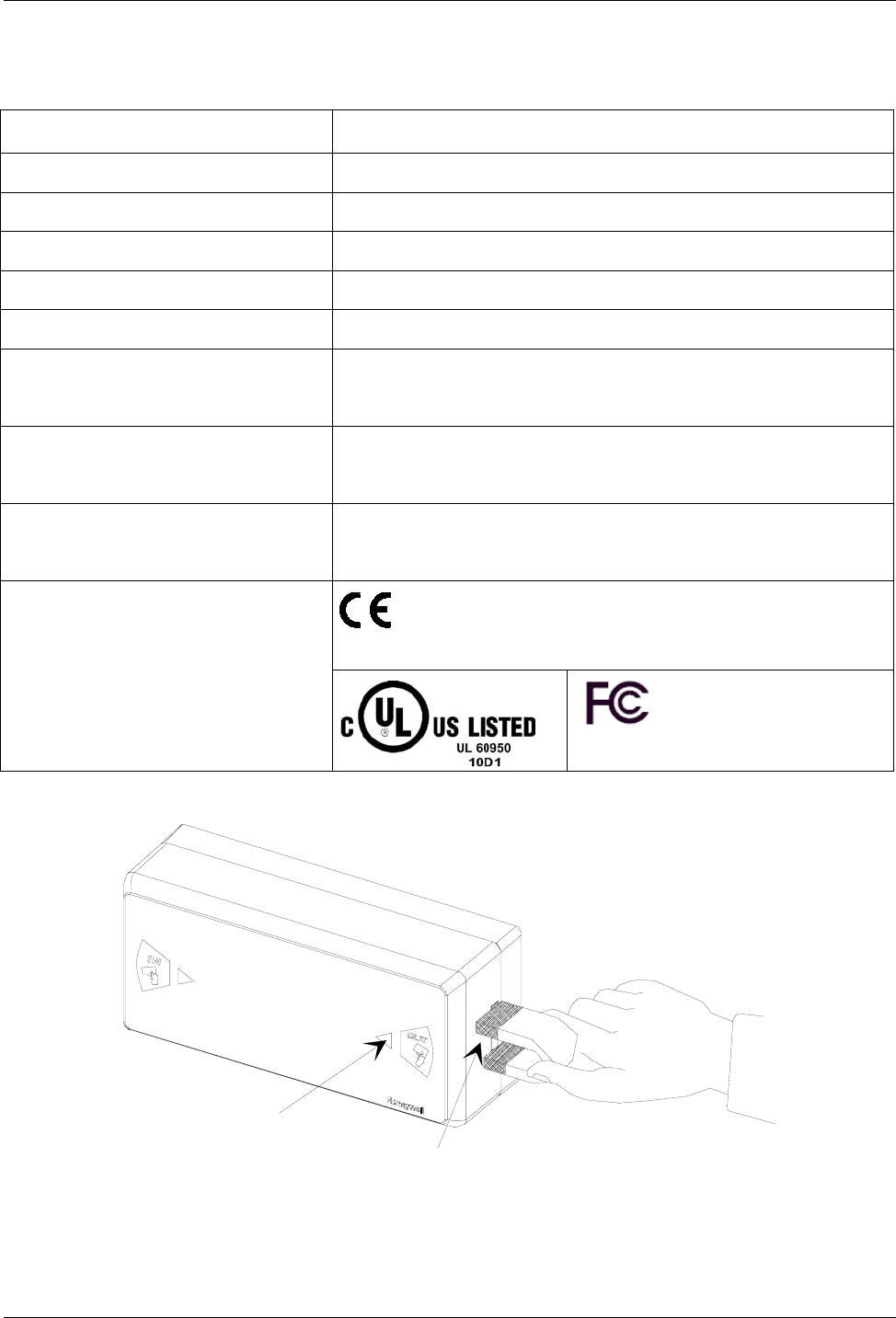
RTU-B07 (Proxy Reader for HID Cards) Page 27
RTU-B07 (Proxy Reader for HID Cards)
Code 1520145
Parameter Value
DC power supply 12VDC±15% 60mA
Weight 0.30 Kg
Dimensions 72 x 160 x 52 mm
IP Protection Rating IP55
Operating temperature 0-50 °C
Proxy receiver For HID cards
Double-antenna receiver (bidirectional)
LONWORKS® connection Unshielded twisted pair cable
(transceiver FTT10A, 78Kbps
Signaling 2 LED tricolor (green/red/yellow)
1 buzzer
Regulations compliance
Directive EMC 89/336/EEC, 92/31/EEC,
Directive Low Voltage 72/23/EEC, 93/68/EEC:
EN60950, EN55024, EN55022, EN 300 330
FCC ID:
HS9-RTU-B07
Service Pin
Ser vice LED
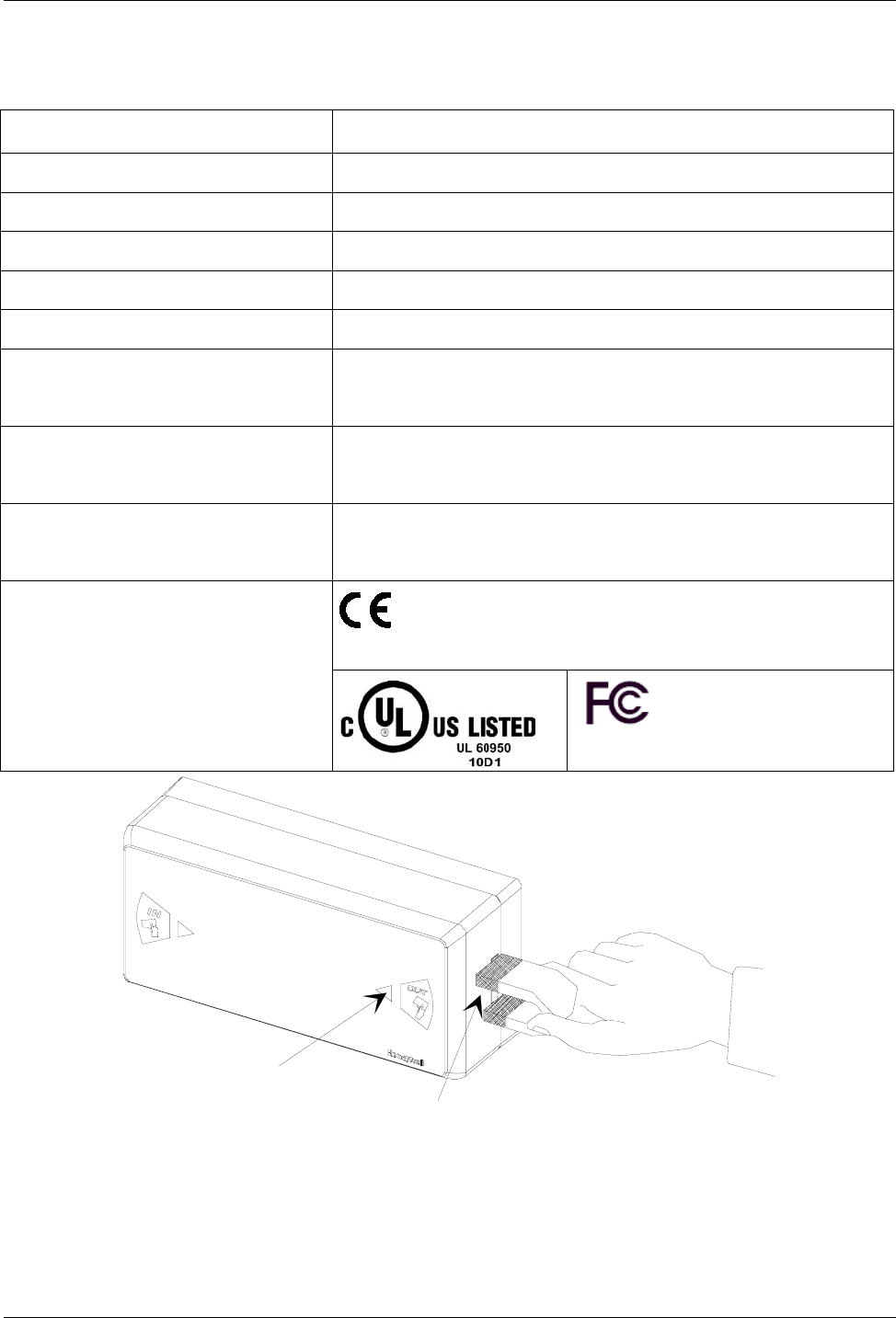
Page 28 RTU-B12 (Proxy Reader for MIFARE Cards)
RTU-B12 (Proxy Reader for MIFARE Cards)
Code 1500119
Parameter Value
DC power supply 12VDC±15% 90mA
Weight 0.30 Kg
Dimensions 72 x 160 x 52 mm
IP Protection Rating IP55
Operating temperature 0-50 °C
Proxy receiver /
Trasmitter
13.56MHz RX/TX
for MIFARE (ISO14443-2A) cards
LONWORKS® connection Unshielded twisted pair cable
(transceiver FTT10A, 78Kbps
Signaling 2 LED tricolor (green/red/yellow)
1 buzzer
Regulations compliance
Directive EMC 89/336/EEC, 92/31/EEC,
Directive Low Voltage 72/23/EEC, 93/68/EEC:
EN60950, EN55024, EN55022, EN 300 330
FCC ID:
HS9-RTU-B12
Service Pin
Ser vice LED
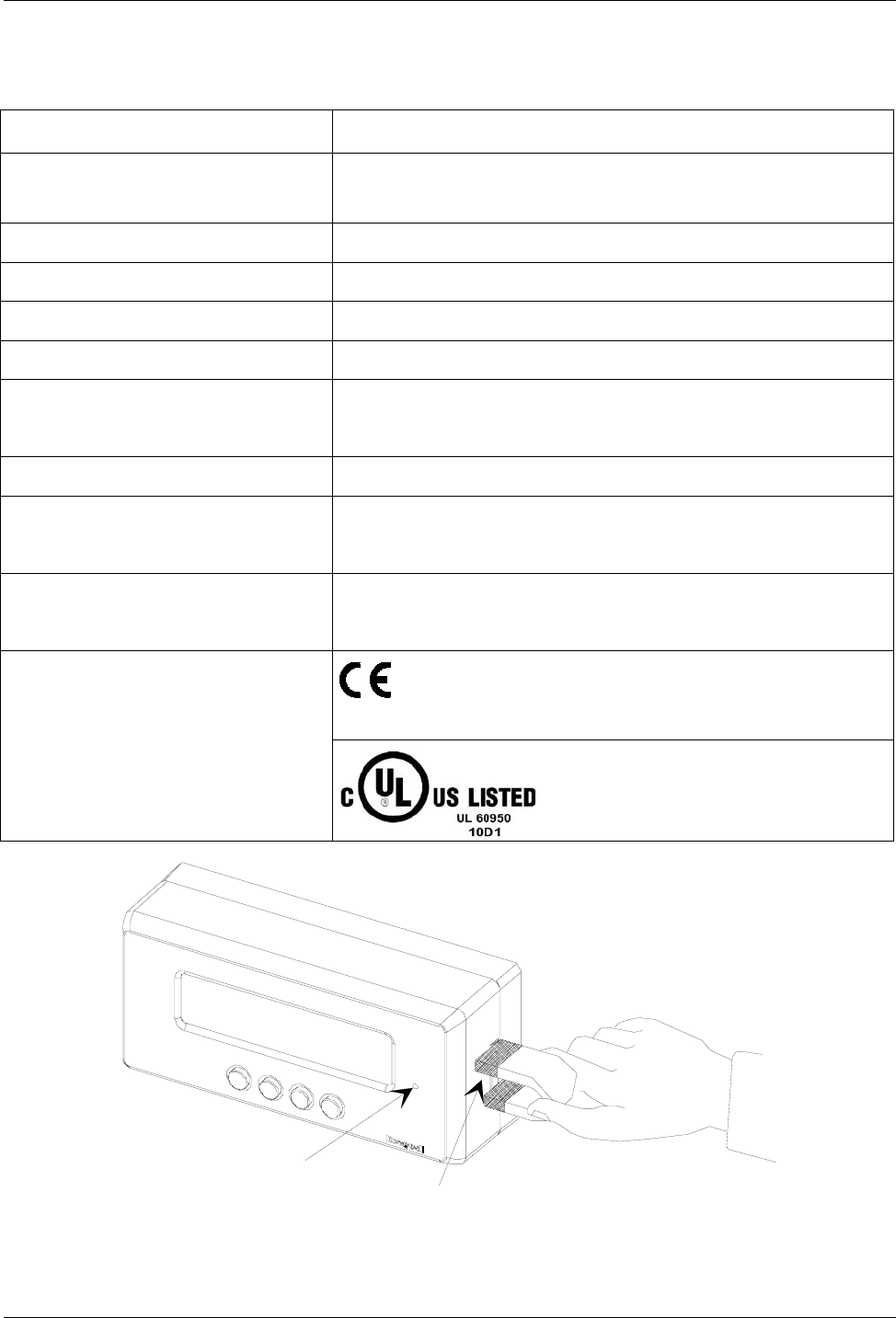
RTU-C01 (Alphanumeric LCD Module) Page 29
RTU-C01 (Alphanumeric LCD Module)
Code 1500105
Parameter Value
DC power supply 12VDC±15% 140mA (nominal)
70mA (backlight off)
Weight 0.30 Kg
Dimensions 72 x 160 x 52 mm
IP Protection Rating IP55
Operating temperature 0-50 °C
Display Alphanumeric LCD with backlight
2 rows of 16 characters format
Keyboard 4 keys with symbols
LONWORKS® connection Unshielded twisted pair cable
(transceiver FTT10A, 78Kbps
Signaling 1 LED yellow
1 buzzer
Regulations compliance
Directive EMC 89/336/EEC, 92/31/EEC,
Directive Low Voltage 72/23/EEC, 93/68/EEC:
EN60950, EN55024, EN55022
Ser vice LED
Service Pin
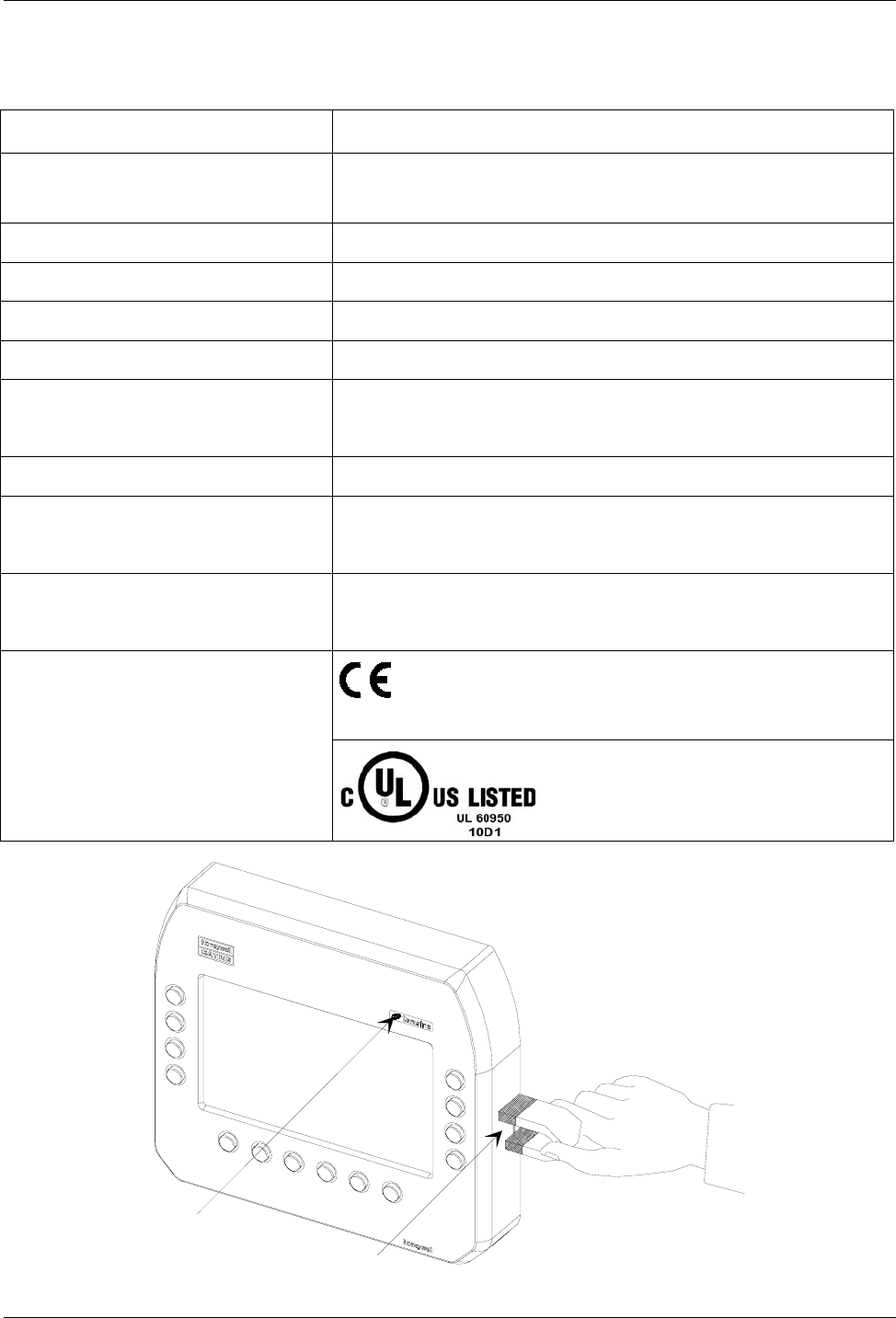
Page 30 RTU-C02 (Graphic LCD Module)
RTU-C02 (Graphic LCD Module)
Code 1500101
Parameter Value
DC power supply 12VDC±15% 380mA (nominal),
140mA (backlight off)
Weight 0.65 Kg
Dimensions 166 x 190 x 52 mm
IP Protection Rating IP55
Operating temperature 0-50 °C
Display Graphic LCD with backlight
240 x 128 pixels format
Keyboard 14 function keys
LONWORKS® connection Unshielded twisted pair cable
(transceiver FTT10A, 78Kbps
Signaling 1 LED yellow
1 buzzer
Regulations compliance
Directive EMC 89/336/EEC, 92/31/EEC,
Directive Low Voltage 72/23/EEC, 93/68/EEC:
EN60950, EN55024, EN55022
Service LED
Service Pin
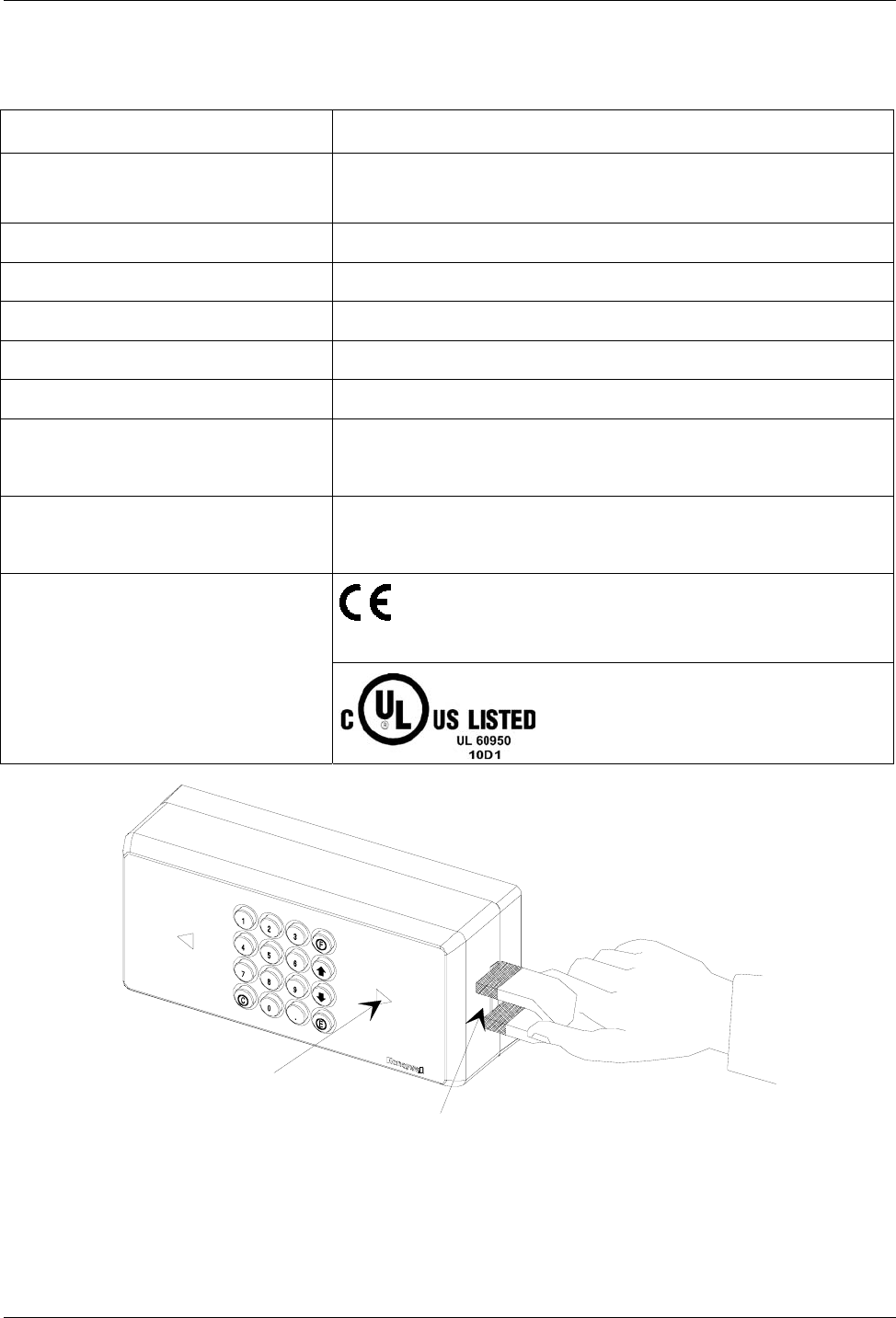
RTU-T01 (Numeric Keyboard Module) Page 31
RTU-T01 (Numeric Keyboard Module)
Code 1500104
Parameter Value
DC power supply 12VDC±15%
30mA (nominal), 50mA (max)
Weight 0.25 Kg
Dimensions 72 x 160 x 52 mm
IP Protection Rating IP55
Operating temperature 0-50 °C
Keyboard 16 keys with symbols
LONWORKS® connection Unshielded twisted pair cable
(transceiver FTT10A, 78Kbps
Signaling 2 LED bicolor (red/green/yellow)
1 buzzer
Regulations compliance
Directive EMC 89/336/EEC, 92/31/EEC,
Directive Low Voltage 72/23/EEC, 93/68/EEC:
EN60950, EN55024, EN55022
Ser vice LED
Service Pin

Page 32 Optional Parts
Optional Parts
Unlocking tool code 3900695AB